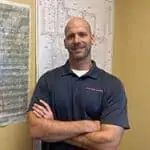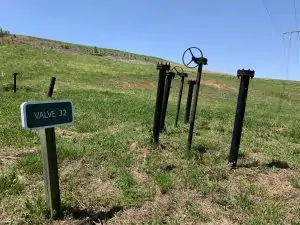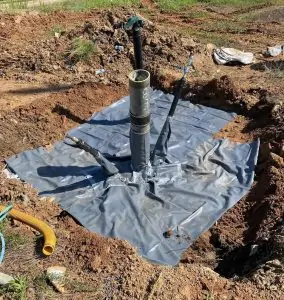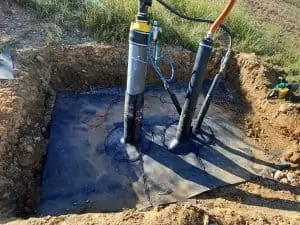

Learn about SCS Engineers Air Emissions Services
Many landfills are still using hand-held monitoring of methane “hot spots” for compliance purposes while relying on models to estimate LFG emissions. Although technological developments in optical remote sensing and other methods offer significant improvements to measuring actual surface emissions from landfills, no single technology or method has risen to the top of the scientific hierarchy, gained universal acceptance, and achieved regulatory approval. Clearly, the technological advances provide more comprehensive methods for measuring methane concentration, identifying methane hot spots and leaks, and providing better coverage of the entire landfill surface. However, some technology falls short in their ability to provide accurate, consistent, and repeatable methane flux or emissions measurements.
As monitoring technology evolves, so have the various ways SCS takes measurements, from source level, drones, and high-altitude aircraft, to satellites. This paper presented at A&WMA by Patrick Sullivan and Raymond Huff summarises and provides details on the following methods:
• First order decay (FOD) modeling for landfills without active LFG collection systems.
• Non-FOD modeling for landfills without active LFG collection systems.
• FOD modeling with measured LFG collection.
• Non-FOD models with various site-specific data input.
• Measured LFG collection with estimated collection efficiency.
• Surface emission monitoring for compliance purposes.
• Ground-based or low-altitude imaging for concentration or hot spot measurement.
• Satellite and aerial imaging for concentration or hot spot measurement.
• Flux chamber testing.
• Ground-level plume measurement.
• Micrometeorology.
• Stationary path measurement.
• Reverse air dispersion modeling.
• Tracer studies.
• Low or high-altitude imaging.
• Hybrid methods.
While performing methane reduction operations and monitoring at the Anchorage Regional Landfill in Alaska, members of the SCS RMC drone team met some pretty amazing people, including Shane Christiansen who works for the Municipality of Anchorage. The RMC team got to know Shane and learned how he and his business partner, Tim Harrington, are helping disabled children.
Shane and Tim run an organization called Children Leaving Tracks (CLT) that has the mission of providing mobile technologies to young people with limited mobility, allowing them to participate more fully in everyday activities with their peers. They believe that providing improved mobility can expand the physical and mental well-being of these kids and offer them greater freedom and quality of life.
Moved by Shane and Tim’s passion and dedication, SCS made a donation, which will provide “Electric All-Terrain Trikes” to three children! “Everyone deserves to have these experiences in life, but unfortunately this kind of technology is not always covered by insurance companies,” says Shane. “This means that some people go their entire life without getting to enjoy all that it has to offer. They don’t have the freedom to [move about] as they please.”
Although still in the early stages, Children Leaving Tracks seeks financial and in-kind donations from sponsors and networking partners. They are working toward creating a corporate/private collaboration that has the single mission of helping disabled children become more mobile for their health and personal growth.
CLT uses funding to run the organization to supply and finance Track Chairs and Electric Trikes. Donations cover the costs of purchasing and shipping these chairs to the kids who need them. Shane and Tim are registering Children Leaving Tracks as a 501c3 non-profit company; they are also starting a parent company aimed to be the primary funding arm that will supply a percentage of revenues from more recreational products it plans to develop.
The ultimate goal is to change the lives of hundreds of children by opening up their world through greater mobility and freedom. The organization helps youngsters gain confidence, better mental and physical health, and create greater opportunities to expand their individual talents. Kudos to Children Leaving Tracks!
Learn more about how this inspirational organization uses new technology to make life better; or to help, please contact Shane Christiansen at 1-907-529-5153.
If you would like to know more about using technology to improve the environment, ask SCS click here.
SCS Engineers is providing landfill gas (LFG) systems operations, monitoring, design, and management for the Yolo County Central Landfill (YCCL). SCS Field Services is SCS’s specialized landfill practice, providing operations, maintenance, and monitoring (Landfill OM&M) for Yolo County and over 600 landfills across the nation.
SCS Field Services identifies practical strategies to optimize the performance of landfill gas (LFG) systems and equipment while working on site. Optimized systems capture more gas.
Project Manager Mike Calmes leads the comprehensive team at YCCL, which has five closed waste management units, five active waste management units, and one under construction. Closed landfills continue generating gas, so active or closed, they all require oversight by these landfill specialists.
“The County understands the importance of preventative strategies using captured landfill data to create sustainable environmental controls. These keep landfills running as efficiently as possible and safely within regulatory compliance,” said Anton Z. Svorinich Jr., SCS Engineers Vice President, Regional OM&M Manager.
To learn more about landfill operations and engineering, visit SCS Engineers.
Landfill efficiency: every landfill owner or operator knows that landfills are distinctly unique. Consequently, landfill gas collection and control systems (GCCS) and leachate management systems with highly engineered components are configured precisely to tailor to each landfill’s needs. North American landfills have always tried to be good neighbors, but now are making greater strides toward reducing emissions and protecting groundwater with master planning and technology. These plans keep the effectiveness of these systems running as efficiently as possible and help prevent expensive and extensive repairs.
Today’s blog takes us out in the field examining how to plan for these flexible high-dollar infrastructure systems. These plans are taking landfill operations into the future and are adaptable to changing regulations around emissions and the evolving waste streams that affect gas production.
We’ll also provide resources to similar articles about leachate systems, remote monitoring systems, drones, and carbon sequestration that are helping to keep your carbon footprint even lower and support landfill efficiency.
In the April issue of WasteAdvantage Magazine, Professional Engineers Vidhya Viswanathan and Maura Dougherty discuss how operators with 5-year and master plans in place get a payoff with a system that serves them well and costs less. They can prepare early for capturing their gas, use the plan to install gas collection infrastructure on a timely basis, and help guide them through post-closure among the daily benefits. Read Master Plan to Lower Your Landfill GCCS Infrastructure Investments here.
Planning/Managing Leachate/PFAS
Remote Monitoring and Control and Drones
The City Council of the City of Lincoln, Nebraska, recently approved a four-year service agreement with SCS Engineers for comprehensive environmental solutions and technology supporting the Solid Waste Management Division and Lincoln Water System.
The contract provides professional engineering and technical support for the City’s two Solid Waste Management Facilities, located on Bluff Road and North 48th Street in Lincoln. Modern landfills such as these contain complex systems to protect the health of nearby communities and the environment. Lincoln’s Solid Waste Management Division uses SCS professionals’ expertise and proprietary software for air quality and gas collection and control systems (GCCS), operations, monitoring, and maintenance. These environmental services keep the landfills fully compliant with regulatory requirements while aligning with the City’s system performance goals and anticipated operational and maintenance activities.
The City is using SCSeTools® software designed for landfills to support managing the monitoring data to gauge operational health continually. The firm’s comprehensive environmental services include sampling and monitoring groundwater, stormwater at both facilities, and leachate analysis at the Bluff Road Landfill.
SCS assists with scheduled testing and reporting to federal, state, and local agencies, including the Environmental Protection Agency, Nebraska’s Department of Environment and Energy, and the Lincoln-Lancaster County Health Department. Primarily these public reports cover monitoring summaries, statistical analyses of analytical results, and review of emission sources, factors, and calculations associated with the GCCS. They also include greenhouse gas reports, estimates, Title V permit requirements and documentation, NPDES General Permit support, and Stormwater Pollution Prevention Plans.
Michael Miller, an SCS vice president and one of the firm’s environmental due diligence experts, said,” We’re privileged that the City of Lincoln entrusts us to partner with its professionals to maintain the landfills’ safe and efficient operations. The Solid Waste Management Division and Lincoln Water System support the citizens with essential services and the environment; we’re honored to assist.”
SCS Engineers shows you in this short video featuring SCS Remote Monitoring & Control technology built for landfill owners and operators, solar farms, and for use on pipelines by SCS Engineers, landfill and environmental practitioners.
The Reno County Board of Commissioners approved contracting with SCS Engineers to support the County’s Solid Waste Department through 2024. SCS will provide environmental engineering, consulting, and field services for the Reno County Municipal Solid Waste Facilities for the next three years. The contract approval directly resulted from the firm’s experience, expertise, and long-standing relationship with Reno County.
SCS has a history of providing compliance, planning, and engineering services to Reno County. The firm helps the County continually comply with the Kansas Department of Health and Environment (KDHE) and other agency regulations. Compliance activities throughout the year include groundwater and leachate sampling, laboratory analyses, permit renewals, air permitting, and associated report preparation in accordance with Kansas Administrative Regulations.
Landfills contain complex systems to protect the health of nearby communities and the environment. The County uses SCS professionals’ expertise and proprietary software for air quality and gas collection and control systems (GCCS) operations, monitoring, and maintenance (OMM). Reno County relies on SCS to maintain these systems and keep them in compliance to focus on their other operations.
These preventative services keep the landfills fully compliant with state and federal regulatory requirements while aligned with the County’s system performance goals and anticipated operational and maintenance activities.
In 2021 the U.S. Environmental Protection Agency (EPA) changed legislation regulating landfills, specifically the New Source Performance Standards (NSPS) and other air quality regulations. These changes significantly increased the monitoring, record-keeping, data management, and reporting tasks for many landfills across the nation, including the Reno County Facility. SCS has helped Reno County navigate these changes and will continue to facilitate changes as the County looks to expand its landfill in the future. Combined with the supply chain and labor shortages, the Solid Waste Department is securing its essential services from disruptions.

Project Director Steve Linehan said, “SCS is privileged that Reno County entrusts us to partner with them to maintain the landfills’ safe and efficient operations. The Solid Waste Department supports the citizens and the environment; we’re honored to help.”
The Fabricated Geomembrane Institute – FGI, discusses allowable leakage rates for industry. We strive for zero leakage and it is possible – this mix of regulators and practitioners including Neil Nowak of SCS Engineers discuss how to achieve it.
Click here to start the video.
The promulgation of 40 CFR 62 Subpart OOO (EG plan), effective since June 21, 2021, impacted all MSW landfills operated under NSPS subpart WWW. One of the major changes of this rule is the requirement to monitor all cover penetrations during quarterly methane surface emission monitoring (SEM). All components that are part of the landfill gas collection system and any other object that completely passes through the landfill cover are considered cover penetrations.

As landfill and landfill gas practitioners, we suggest that advanced planning can save you time and effort. As landfills face short 10-day correction periods, coupled with supply chain and labor shortages, planning can make operations and compliance more efficient. We present a few scenarios and suggestions here.
You’ll need to record any reading greater than 500 ppm above background as an exceedance location during monitoring. These require taking corrective actions such as cover maintenance or landfill gas wellfield adjustments, along with monitoring the exceedant locations again within 10-days of your initial monitoring. If 10-day monitoring still shows methane concentrations greater than 500 ppm, you’ll need additional corrective actions and to monitor the location once more within 10-days of the second exceedance.
Once the location(s) shows methane concentrations less than 500 ppm, it is mandatory to monitor these locations again one month from the very first reading showing the exceedance. If a location shows methane concentration greater than 500 ppm for three occasions in one quarter, the addition of a collection device, other improvements to the collection system, or a request for an alternative remedy and timeline is required. Therefore, implementing appropriate corrective action within the specified timeframe is critical to avoid expensive GCCS expansions or NOVs.
Gas well, well boots, leachate risers, below and above-grade pipe transition, condensate sumps, and valve vaults are some of the common exceedant penetration locations. Implementing corrective action at these penetrations within the given timeframe is a challenging ordeal for landfill operators. Corrective action can vary depending upon several factors: the methane concentration observed during initial monitoring, the location of the penetration, cover type (geomembrane capped vs. soil capped), material availability, and resources available to perform the work.
Corrective actions have varying material and effort requirements; one solution cannot fit all challenges. The most common corrective actions include applying expanding foam, soil mounding, excavation, clean dirt fill or bentonite fill, well boot repairs, installing a prefabricated well boot seal, and installing a vacuum line for emission control. We recommend before starting your monitoring operators consider the following factors:
Develop an educated estimate for the number of expected exceedant penetrations from the landfill sections that historically show cover exceedances or are in areas with problematic operating conditions. Using the readings and data collected over time makes identifying these areas much easier.
Decide the type of corrective action to implement based on your cover type in those expected exceedance locations.
Procure corrective action materials such as bentonite, geomembrane for boot fabrication matching permitted cap material, or prefabricated seals before you need them.
Check the availability of contractors for liner or well boot repairs, and their response time, before you need them.
Surface emissions vary based on the operating conditions; therefore, it is common to see a variable number of exceedances from one quarterly monitoring event to the next. At one of our sites that had no surface exceedances observed during the previous quarterly SEM event, multiple penetrations observed methane concentration greater than 500 ppm during the following quarterly event. One section of the landfill with a soil cap observed methane concentrations up to 16,000 ppm. The geomembrane capped section observed penetration concentrations of up to 8,000 ppm methane. We implemented various corrective actions to bring these exceedant locations to compliance.

In the soil-capped section, we implemented bentonite plugs, prefabricated seals, and site fabricated geomembrane seals depending upon the observed methane concentration, exceedant location, and material availability. Pre-planning and procuring material ahead of time proved to be very helpful.
For each of these corrective actions, we opened an area about 2-ft deep and 10-ft x 10-ft. For bentonite corrective action, about a 9-inch thick bentonite slurry was filled, extending about 5-ft on each side of penetration and then filled with clean dirt.
Prefabricated seals that come in standard sizes as a slip-on for penetrations and site-fabricated geomembrane seals also covered at least a 5-ft x 5-ft area around each penetration. The sleeves at each penetration were left at least 6-inch over the ground surface after filling the excavated section with clean dirt.

In the geomembrane-capped section, we choose to use well boot repairs using geomembrane. Our task was to identify the type of geomembrane used in the cap, procure the geomembrane, identify and schedule the contractor, and install well boots in each exceeding penetration location within the 10-day timeframe. After the well boot fabrication and installation, we needed to carefully reconnect the existing drainage layer.

Implementing these corrective actions can get expensive; prefabricated seals can cost up to $300 per penetration, excluding installation. Material and contractor’s availabilities are also a significant challenge. While implementing these corrective actions, additional unforeseen challenges can arise as well. Planning ahead and having the material on site is very important for landfill operators to keep the landfill under compliance.
About the Authors:
Shrawan Singh, Ph.D., PE, is a Senior Project Professional. Stephen Descher is a Senior Project Professional. You can reach both at SCS Engineers.
SCSeTools® – Developed by Landfill Gas Practitioners for Landfill Owners and Operators
The Birth of LFG Data Tracking
In the early 2000s tracking landfill gas data at facilities was anything but uniform, organized, or secure. The industry was using various methods to track data on paper forms and logbooks, then transferring it by hand into spreadsheets. Some of us used desktop database applications, but as the saying goes, necessity is the mother of invention.
From an SCS employee’s idea for demonstrating how to use landfill gas monitoring data to analyze and pinpoint system corrections, SCS DataServices® was born. In the span of several months, a team of SCS’s landfill engineers, field technicians, and technology gurus worked with client-needs to create a concept application visualizing collected landfill data on maps. Our staff field-tested it with good results, and SCS Field Services began using the application to visualize issues with wellfields that aren’t readily apparent when looking at spreadsheets.
A large SCS landfill client had seen our field staff using DataServices, asked if SCS would consider providing them with access to the application on a subscription basis. Our team adapted DataServices, added features, and continued improvements tailored for the client’s use.
As soon as secure data transfer became feasible, SCS moved to an Internet-based solution for our landfill gas practitioners. The platform called SCSeTools® holds the data collected by SCS DataServices®.
Applications and features roll out as we continually update and upgrade, incorporating ideas and improvements from our users and staff along the way. DataServices is addressing the landfill gas management needs of over 600 landfills across the US and Canada in 2021.
The keys to success follow our mission and values of maintaining close communications with our clients, field staff, engineers, and eTools support staff (all landfill gas practitioners), with the help of software engineers. Technology companies are not up at night thinking about landfill operations, but we are.
We introduce our SCS eTools landfill technology capabilities and a few of the creative and talented SCSers behind the technology in the next segment. Our speakers walk you through demonstrations of how over one-third of the landfill owners and operators in North America are increasing efficiencies using SCS eTools.
Visualizing Landfill Challenges – Shortcuts to Keeping Your Wellfield in Balance
DataServices shows the entire wellfield for any monitored parameters and zooms in on troublesome areas or wells. Results can be as simple or detailed as the landfill owners’ environmental and business needs dictate. The detailed examples here illustrate how graphs, maps, and charts help keep the wellfield in balance. We link each challenge to the description of a video demonstration.
In balance means extracting more gas for renewable energy, preventing odors and methane migration, keeps subsurface and surface conditions and workers safe. The information can help diagnose equipment conditions before they become costly, maintain regulatory compliance, and support cost estimates if the landfill is expanding or more infrastructure investment or equipment is needed.
Looking at vacuum distribution across a gas collection system – Select the system pressure map, which highlights vacuum distribution across the wellfield to show the wells with good (expected) vacuum, pressure drop over distance, and any wells unexpectantly losing vacuum. Zooming in and changing the vacuum ranges further enhances where to assign staff to troubleshoot any identified issues.
Using a methane distribution map shows whether the wells are tuned to where the landfill owner wants them. Wells may be identified below the targeted range, indicating slight over pulling; a technician can use this map to identify such issues and quickly check the identified wells. Wells identified above the desired methane tuning range indicate wells not collecting enough gas, which has consequences. These wells can be the source of odors, leachate seeps, possible lateral migration to an out of waste probe. Not sending enough fuel to a power plant or atmospheric releases can affect surface emissions monitoring.
Managing liquids – Changing waste streams and more rainfall in certain areas of the country complicates liquids management. DataServices visualizes the impacts of liquids on wells and helps landfill owners better manage a proper liquids removal program. The program will let them know how many pumps to budget for and, over time, where to relocate well dewatering pumps so that they are most efficient at removing liquids from landfills.
High-BTU Gas Plants –Filter maps help users locate wells contributing to gas dilution into renewable energy plants. It can help create punch lists for landfill staff to investigate, troubleshoot and tune. As wellfield technicians make corrections, they show on the map in real-time.
Temperature and subsurface oxidation events – Some call the condition subsurface fires, but this is a serious issue for landfills. Over-pulling wells, damaged infrastructure, and other conditions can cause oxidation events. Using a combination of temperature Parameter Maps to review wellhead temperature distribution and a Points Chart feature provides a deeper dive into the data. It provides more insight into which well or wells may be contributing to the high-temperature issues.
Locating a specific well – That’s not so easy when hundreds of wells surround you and at larger landfills. DataServices had built-in filter features to identify a single monitoring point on a wellfield map easily.
Customizing for compliance, best practices, and rules – DataServices allows monitoring points across a single site to have customized rules for each monitoring point. Rules can be for regulatory purposes, standard operating procedures, best management practices, and even site-specific preferences or any combination thereof. It is efficient to customize rule application to landfills and collection points – meaning wells, probes or ports, horizontal collectors. This customization capability helps organize and confirm regulatory compliance. It is especially salient with the 2021 EPA and state compliance changes for a single landfill or an organization with hundreds of landfills.
MobileForms – Inspection forms, blower flare station monitoring forms, load tracking from municipalities, incoming hazardous waste tracking, MRF bale counts are examples of paperless entry available. The data feeds directly from mobile phones to the supervisor and into the maintenance department, so staff can start cataloging and looking at what’s going on in real-time at several types of facilities. It’s available for regulators and inspections and helps reduce staff hours tabulating and centralizing the information. Any information historically captured on a form or log attached to a clipboard can now be captured and stored electronically. From there, it can be recovered and produced as a PDF export file or data from the forms used to trend data and help make informed operational decisions.
MobileTools – DataServices in a condensed format suitable for mobile devices. Field staff use MobileTools to save time formerly used to return to the office, transfer/transcribe the collected data and upload it to a supervisor for quality checks before storage. Technicians can now recall the last 20 readings for any given well and review trend graphs on their phones or tablets while standing adjacent to the well they have questions about and need to access the data. MobileTools also allows them to upload field data such as liquid level readings while the data is being collected. The information instantly populates into DataServices and is available for review by others on the project team.
The most valuable tools are in development now for release in 2022. ARC GIS integration developed under SCS RMC® will further enhance DataServices with even better visualization and location capabilities and provide enhanced features such as allowing landfill owners to see their well as-built information and view subsurface information about their wells.
Learn more at SCS Engineers, where we adopt our clients’ environmental challenges as our own.